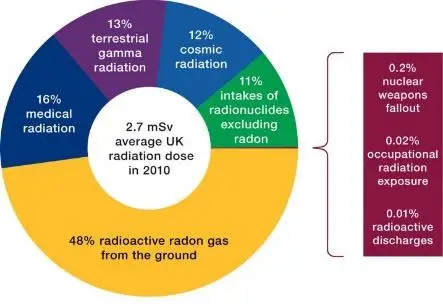Radiation
Scientific background information
1. Radiation is part of our daily lives
Radiation is all around us and has been present since the birth of this planet. We are routinely exposed to naturally occurring (background) radiation from outer space, the sun, the ground, and even from within our bodies.
Radiation is energy in the form of waves or particles. This commonly includes:
- electromagnetic radiation, such as radio waves, microwaves, infrared, visible light, ultraviolet, x-rays, and gamma radiation;
- particle radiation, such as alpha radiation (α), beta radiation (β), proton radiation and neutron radiation (see Figure 1).
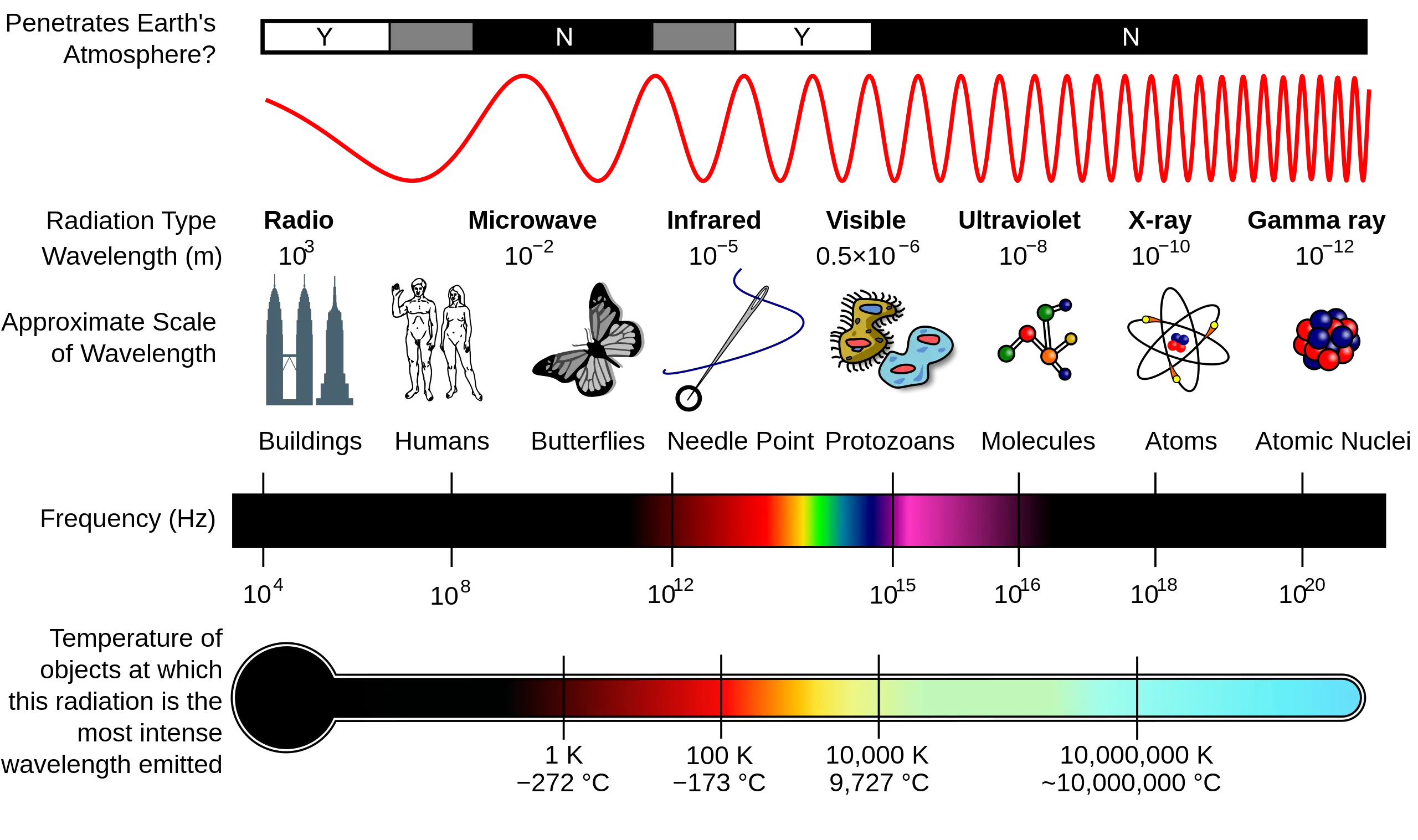
https://commons.wikimedia.org/wiki/File:EM_Spectrum_Properties_edit.svg
Non-ionising radiation
Non-ionising radiation includes low-frequency and moderately high-frequency radiation, including radio waves, microwaves, infrared radiation and visible light. Non-ionising radiation has enough energy to move around the atoms in a molecule or cause them to vibrate but not enough to remove electrons. Non-ionising radiation is used in many everyday tasks. We use:
- Microwave radiation for telecommunications and heating food.
- Infrared radiation for infrared lamps to keep food warm in restaurants.
- Radio waves for radio broadcasting.
High-frequency sources of non-ionising and ionising radiation (such as the sun and ultraviolet) can cause burns and tissue damage with overexposure.
Electromagnetic fields (EMF):
Electric and magnetic fields, also known as electromagnetic fields (EMF), consist of waves of electric and magnetic energy moving together. These energy fields surround us all the time. Scientific studies have not clearly shown whether exposure to EMF increases health risk. A few studies have connected EMF and health effects, but they have not been able to be repeated. This means that they are inconclusive. Scientists continue to research the issue. Electric fields are produced by electric charges, and magnetic fields are produced by the flow of electrical current through wires or electrical devices. The strength of the EMF is proportional to the amount of electrical current passing through the power line and decreases with distance.
Electromagnetic Radiation From Wireless Technology
Electronic devices that send electromagnetic signals through the air in Radiofrequency (RF) are everywhere: Wi-Fi routers, cell phones, radios, and other networks. They transmit information in the form of radio waves. We are in a constant cloud of electromagnetic radiation. Some people are concerned about the potential health effects of Electromagnetic Radiation from wireless technology. Cell phones and wireless networks send Electromagnetic Radiation in Radiofrequency at energy levels that do not cause significant heating. Most studies have not found any health effects from cell phone use. A few studies have connected RF and health effects, but scientists have not been able to repeat the outcomes. This means that they are inconclusive [2].
Radio waves frequency radiation from cell phones is not strong enough to directly affect the structure of atoms or damage DNA; however, it does cause atoms to vibrate, which can cause them to heat up. When Radio waves' energy is very strong, such as from radar transmitters, it can be dangerous. It can heat parts of the human body very rapidly and cause serious injuries, like severe burns. Radiofrequency energy decreases as it travels in the atmosphere, which means that it gets weaker the farther it is from the transmitter. Cell phone towers may broadcast higher levels of RF energy, so they have warnings that limit access to the tower itself or the surrounding area [3].
Mobile telecommunication technologies (e.g. mobile phones) transmit and receive radiofrequency electromagnetic fields (RF EMFs) in defined ways that allow communication. The specific method of utilising the RF EMFs is referred to as a "wireless standard". For example, the wireless standard used for the First Generation of mobile telecommunication is referred to as "1G", while the fifth generation of the wireless standard has emerged, known as "5G".
RF effects on the body and health implications
Electromagnetic Radiation from wireless technology can penetrate the human body, with the main effect of this being a rise in temperature in the exposed tissue. The human body can adjust to small temperature increases like when undertaking exercise, bathing or in the sauna. This is because the body can regulate its internal temperature.
Another general characteristic is that the higher the frequency, the lower the depth of penetration of the EM Radiation from wireless technology into the body. As 5G technologies use higher frequencies (>24 GHz), they will be primarily absorbed superficially (and less getting into the brain tissue) than that previous mobile telecommunications technologies (4G, etc.). However, although the proportion of power that is absorbed superficially (as opposed to deeper in the body) is larger for the higher frequencies, the ICNIRP (2020) restrictions have been set to ensure that the resultant peak spatial power will remain far lower than that required to affect health adversely. Accordingly, 5G exposures will not cause any harm, as they adhere to the ICNIRP (2020) guidelines. Raising concerns over the use of 5G are not new; similar concerns were reflected concerning 1G, 2G, 3G, and 4G. Irrespective of these concerns, brain cancer rates have not appreciably changed, moving from no phone handset used in the 80s to overwhelming use by most of the population in Western countries today [4.1] [4.2] [4.3].
Use of microwaves
Microwave ovens use electromagnetic radiation to heat food. The non-ionizing radiation used by a microwave does not make the food radioactive. Microwaves are only produced when the oven is operating. The microwaves produced inside the oven are absorbed by food and produce the heat that cooks the food. Microwave ovens are constructed to ensure that electromagnetic radiation does not leave the oven.
Ionising Radiation
Ionising radiation includes higher frequency electromagnetic radiation: ultraviolet, x-rays and gamma rays. Ionising radiation has enough energy to break chemical bonds in molecules or remove electrons from atoms, creating charged molecules or atoms (ions). Ionising radiation can damage living tissue by changing cell structure and damaging DNA. The damage depends on the type of radiation, exposure pathway, energy, and the total amount of radiation absorbed. The effect from minor or even moderate exposure may not be noticeable. Most cellular damage is repaired. However, some cells may not recover as well as others and could become damaged or cancerous. Radiation also can kill cells. Children are more sensitive to ionising radiation than adults because children are still in the process of growing. More cells are dividing, and a greater opportunity for radiation to disrupt the growth process.
The sievert (symbol: Sv) is a unit of ionising radiation dose in the International System of Units (SI) and measures the health effect of ionising radiation on the human body. The sievert is important in dosimetry and radiation protection. It is named after Rolf Maximilian Sievert, a Swedish medical physicist renowned for his work on radiation dose measurement and research into the biological effects of radiation.
Ionising radiation and cancer
The most significant risk from exposure to ionising radiation is cancer. Studies of more than 100,000 survivors of the atomic bombs in Hiroshima and Nagasaki, Japan, at the end of World War II show:
- The chance of developing cancer increases as the radiation dose increases.
- Cancers caused by radiation do not appear until years after exposure.
- Some people are more likely to develop cancer from radiation exposure than others.
Ultraviolet (UV) Radiation and Sun Exposure
The sun sends energy to Earth in a few different ways: visible light that we can see, infrared radiation that feels like heat, and rays of UV radiation that we cannot see or feel. UV rays cause skin ageing and eye damage and can lower your body's ability to fight off illness. Shorter wavelength UV rays (so-called UVB) cause sunburns and skin cancer. Skin cancer incidence in the EU reaches 90,000 new cases annually, more than half of them in Sweden. It is one of the fastest-rising forms of cancer [5].
While everyone should protect themselves against UV radiation, it is crucial to protect children. Most of an average person's UV exposure from the sun occurs before the age of 18. Too much UV exposure or frequent sunburns, particularly during childhood, can make developing skin cancer more likely.
Information related to public misconceptions
During the last few years, students and the public, in general, are becoming more and more interested in radiation [6]. Mobile phones, modern game consoles, and WiFi—all devices involving some radiation are part of our everyday lives. People are also frequently confronted in the media with debates relating to different types of radiation: All radiation is bad! Is medical radiation really necessary? Does radiation from mobile phones cause cancer? Should solariums be forbidden? What are the effects of nuclear contamination from nuclear power plants?
Although students often seem very motivated to learn about radiation, several misconceptions about this topic might be brought into the physics classroom. Some of these misconceptions might be caused by biased media reports, while others can be attributed to a different usage of the word radiation in everyday language.
Concerns about 5G
5G is the fifth-generation technology standard for broadband cellular networks. It promises a ten-fold increase in data transmission rates compared to current 4G networks, which will be achieved using a higher transmission frequency.
Due to higher frequencies and subsequently shorter wavelength, 5G will require much denser infrastructure compared to 3G or 4G deployments – cell antennas should be every 100 to 200 meters. Compared to earlier technologies, 5G will employ beam-forming antennas to focus signals more efficiently towards the device in use, rather than having the signal spread in broad directions as in current base station antennas.
As the frequency increases, the depth of penetration into biological tissues decreases. Hence, the skin and eyes become the main organs of health concern. Millimetre waves are absorbed mainly by the skin and in the surface layers of the cornea.
According to several expert agencies – there is nothing to suggest 5G millimetre waves have a significant health risk [7]. However, many experts say more quality research is needed. 5G high-band frequencies are still non-ionizing, so this radiation does not have enough energy to break apart DNA and directly cause changes to cells that could lead to cancer. Most studies published on the use of traditional cell phone service in the radio-frequency range have not found a link with the development of tumours [8]. Tissue heating is the primary interaction mechanism between radiofrequency fields and the human body. Radiofrequency exposure levels from current technologies (2, 3, 4G) result in negligible temperature rise (a few tenths of a degree) in the human body.
However, some of the scientists mentioned above point out that, in the particular case of 5G, the issue is not the potency, but the pulse, the frequency to which the whole population will be exposed due to the dense network of antennas and the estimated billions of simultaneous connections. Studies show that pulsed electromagnetic fields (EMF) are, in most cases, more biologically active and, therefore, more dangerous than non-pulsed EMF [9].
Thus, some experts suspect that the radiation from these devices could damage cells via another biological mechanism, such as oxidative stress in cells, which leads to inflammation, and cell and tissue damage. There have been opinions that short-term exposure can have adverse physiological effects on the peripheral nervous system, the cardiovascular system [10] and the immune system (affecting the immune response in our skin) [11]. Nevertheless, those opinions are drawn from a few studies, mainly focussed on WiFi frequency bands (2.4 GHz and 5 GHz). [12]
Man-made radiation as the source of radiation exposure
Many people think that radiation is a direct result of technological progress produced by electrical devices or comes from nuclear power plants. People sometimes assume that living far away from congested urban and industrial areas will significantly reduce radiation exposure or that there was no radiation some centuries ago. This is not true.
The idea that light is a type of radiation closely related to x-rays or microwaves is challenging to grasp for students. Light, in their opinion, is very different from radiation: it is visible, whereas people usually consider radiation invisible, and light seems to be exclusively associated with positive emotions. Visible light is non-ionising radiation, but how about ionising radiation?
Except for potential large-scale nuclear accidents, natural ionising radiation is the most significant contributor to the collective effective dose received by the world population. The human population is continuously exposed to ionising radiation from several natural sources that can be classified into two broad categories: high-energy cosmic rays (cosmic contribution); and radioactive nuclides present in the Earth’s crust (terrestrial contribution). The terrestrial contribution is mainly composed of the radionuclides of the uranium and thorium decay chains and radioactive potassium. In most circumstances, radon, a noble gas produced in the radioactive decay of uranium, is the most important contributor to radiation exposure. [13]
Figure 2. Contribution of different radiation sources to average population annual effective radiation dose
However, the contributions from different sources vary, and the proportion of man-made radiation increases with emerging medical technologies. Public health England has estimated that the proportion of radon in annual doses in the UK could be around half. Whereas in Germany, the radon contribution is around a quarter. The other more significant contributors are cosmic radiation, terrestrial gamma radiation and ingestion (e.g. food) of radionuclides other than radon.
Medical radiation
As described previously, medical radiation currently gives a higher proportion of population exposure than earlier. In the US, the proportion of total radiation exposure from medical sources has grown from 15% in the early 1980s to 50% today. Most of the increased exposure is due to computer tomography (CT) scanning and nuclear imaging, which require larger radiation doses than traditional x-rays. Computed tomography scans are x-raying procedures that create cross-sectional views and three-dimensional images of a patient's internal organs. When a person has a CT scan, many x-rays are taken at nearly the same time. CT scans create very clear images of internal organs. These detailed images help doctors diagnose problems inside the body, such as tumours or organ damage. CT scans can also provide surgeons with a map of the inside of the patient that they can follow when operating. When a person has a CT scan, they are exposed to much more radiation than a conventional x-ray. A chest x-ray, for example, delivers 0.1 mSv, while a chest CT delivers 7 mSv — 70 times as much.
The radiation is emitted by external sources, and a person is only exposed during the procedures. There is no radioactive effect afterwards [16]. However, during nuclear medicine procedures, patients take radiopharmaceuticals that will be used in their treatment or procedure. All radionuclides have a "half-life," which is the time it takes to decay away. Patients may continue to emit detectable radiation levels for different periods after different treatments. Tc-99m (technetium-99m) is detectable for 3-4 days; fluorine-18 (F-18) that the most common radioisotope used, is detectable for a day; technetium-99 m (Tc-99m) and thallium-201 (Tl-201) or a combination of both that are used in myocardial perfusion (blood flow) imaging remain detectable for few days and up to a month, respectively. Iodine-131 (I-131), used to treat hyperthyroidism, thyroid cancer and lymphoma, may remain detectable for as long as three months after treatment [16]. During that period small amount of ionising radiation is emitted by our body; thus, one can say being radioactive. However, the emitted amounts of radiation are low and nuclear medicine, as the non-invasive method, has several benefits compared to invasive methods. Much higher doses are given in radiation therapy used to treat cancerous cells in the body. The typical doses are around 50,000 mSv divided into multiple smaller doses over a few months. The most common type of radiation therapy is external-beam radiation therapy, where patients get radiation doses from medical equipment [18]. After procedures, no radiation is released.
Another procedure is internal radiation therapy when radioactive material is placed into cancer or surrounding tissue in implants. Implants may be permanent or temporary. As radioactive material decays, the implants lose radioactivity over time, and the inactive seeds can stay in the body. Thus during a specific period (often up to 2 months), the patient should not have close or more than 5 minutes of contact with children or pregnant women.
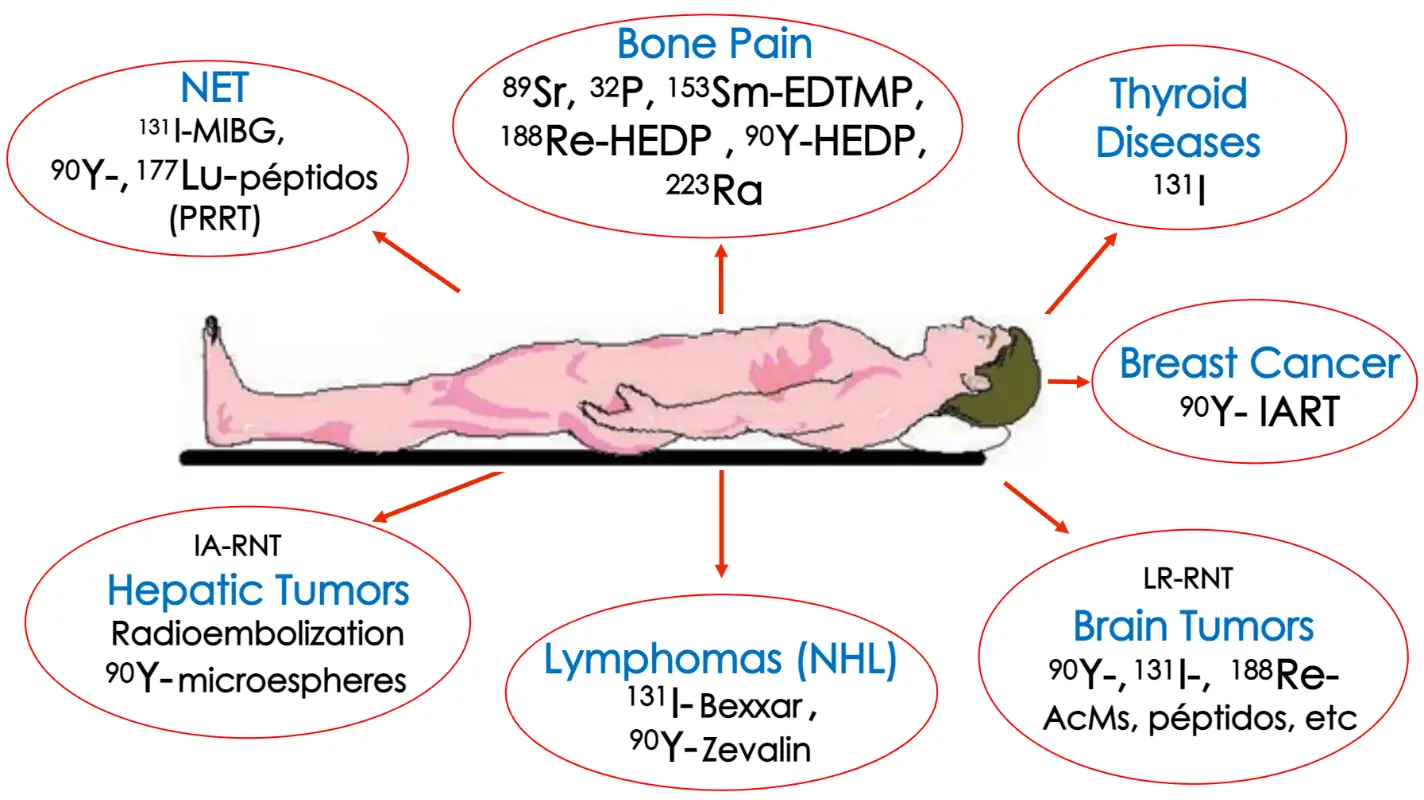
https://slideplayer.com/slide/10275303/
Food irradiation
Food irradiation is the technology that exposes food to ionising radiation. The essence of the process is that radiation disrupts a cell’s chromosomal DNA; if the cell cannot repair that lesion, it dies. This can prevent sprouting in potatoes, killing insects in grains and fruits and inactivating parasites in the meat. Radiation like pasteurisation significantly reduces bacteria in the food, whereas higher doses will sterilise food. Most commonly, radioactive isotopes such as cobalt-60 and cesium-137, which produce gamma rays with suitable energies, are used.
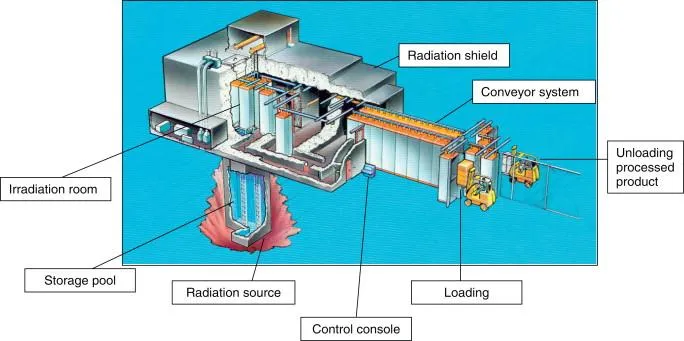
Motarjemi Y, Moy G, Todd ECD. Encyclopedia of Food Safety: Elsevier (2014).
Nowadays, people are more aware of the food they eat than at any other time in history. Even if these energies for food irradiation are too low to induce radioactivity, some people are wary of irradiated food. Even though food irradiation poses no toxicological, microbiological, or nutritional problems [21], it does reduce vitamin levels in foods, especially for the B group vitamins. However, during traditional cooking, similar vitamin loss can be observed [22]. Food irradiation has nothing to do with radioactive contamination, as food does not come in contact with radioactive material during irradiation and cannot be contaminated this way.

U.S. Department of Energy
Suntanning
Some indoor tanning lobby groups say that because tanning machines use mostly UVA light, tanning that way is safer than lying in the sun. This is not true. Ultraviolet radiation (UV) is classified into UVA (wavelength from 320 to 400 nm), UVB (290 to 315 nm), and UVC (100 to 280 nm) radiation. For years, scientists believed that UVB rays are more harmful because they induce sunburn linked to melanoma. We know that UVA rays induce photoaging and increase skin cancer risk [23]. So there is no such thing as a safe or healthy tan. UVA rays, while slightly less intense than UVB, penetrate your skin more deeply. Exposure causes genetic damage to cells on the innermost part of your top layer of skin, where most skin cancers occur. The skin tries to prevent further damage by darkening, resulting in a tan. UVA radiation is the primary type of light used in most tanning beds. Once thought to be safe, we now know it is just the opposite. Just one indoor tanning session can increase the risk of developing skin cancer (melanoma by 20%, squamous cell carcinoma by 67%, and basal cell carcinoma by 29%) [24]. The American Academy of Ophthalmology reports that tanning beds produce 100 times higher UV levels or the expected intensity of ultraviolet radiation than you would get from the sun [25]. This is reflected in allowable short tanning times (e.g. with white or pale skin, even a one-minute session).
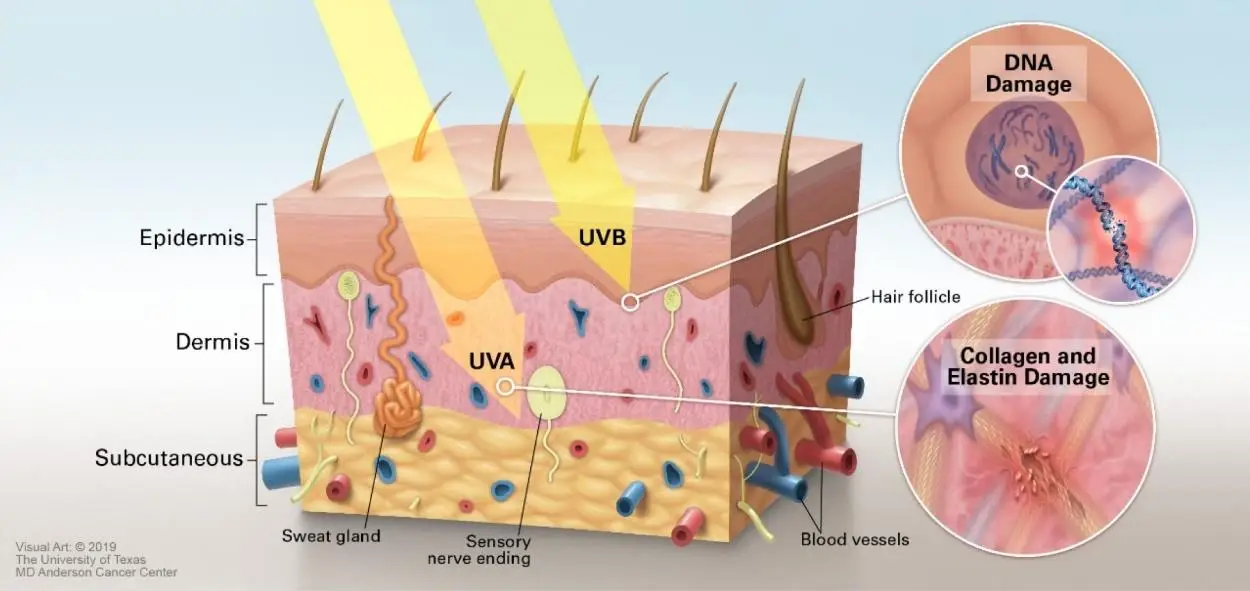
https://www.mdanderson.org/publications/focused-on-health/what-s-the-difference-between-uva-and-uvb-rays-.h15-1592991.html
2. Fears of Nuclear energy
Our students usually are not well informed about nuclear energy but have intuitive radiation fears. This problem has historical roots. From the beginning, nuclear research and development were controlled by the military, and much of the information was concealed for national security purposes. The nuclear bombing of Hiroshima and Nagasaki and the post-WWII competition between the Soviet Union and the USA created a foundation for fear and mysticism around nuclear. Radiation from testing nuclear weapons in the atmosphere is still present in the air we breathe sixty years after such tests were banned.
Furthermore, the lack of information provided by the Soviet government around the Chornobyl nuclear power plant after the accident, as well as the following international media campaign presenting exaggerated threats reports to the world community, increased public stress and made public opinion towards nuclear energy even more negative. Studies report that “the mental health impact of Chernobyl is the largest public health problem created by accident. These problems manifest as negative self-assessments of health, belief in a shortened life expectancy, lack of initiative, and dependency on assistance from the state” (WHO/IAEA/UNDP 2005). However, of the people known to have received a high radiation dose from Chernobyl, the increase in cancer incidence is too small to measure due to other causes of cancer, such as air pollution and tobacco use. Public health data do not establish cancer occurrence following exposure to low doses below 100 mSv. Studies of occupational workers chronically exposed to low radiation levels above normal background have shown no adverse biological effects. The biological effects of low-doses radiation are still underexplored. Intuitively we assume that any amount of radiation may pose some risk of causing cancer and hereditary effect and that the risk is higher for higher radiation exposures. Currently, scientists are starting to reconsider the effects of radiation exposure, suggesting that human bodies can handle low and medium dosages of radiation without observable health deterioration effects. However, TV shows, pop culture and even news reporters often exploit incomplete information or subjective ideas for the sake of drama as viewers like a good drama, which lead to exaggerated fears of radiation – radiophobia. [27] [28]
Depending on time availabilty, teacher can narrow work with Radiation module to myths related to nuclear energy and nuclear radiation. Below, we present some myths that student groups can share among them to get deeper insights into and prepare video-explanations about (activities 2-5).
3. Facts related to common myths about nuclear energy [29] [30]
Myth 1: Nuclear energy is not safe
The three accidents of nuclear reactors in Three Mile Island, Chernobyl and Fukushima Daiichi, occurred over a time frame of 65 years. Of these three accidents, two had no fatalities related to nuclear radiation and Chernobyl had about 50 fatalities immediately related to nuclear radiation [31]. Although a further 4,000 fatalities resulting from cancer might be related to the Chernobyl accident, the overall fatality rate remains lower than that attributed to other forms of energy production. “The death toll from nuclear energy is 442 times fewer relative to brown coal per unit of energy, even with radioactive exposure deaths included [32].”
Myth 2: Nuclear energy contributes to carbon emissions and thus leads to atmospheric pollution and global warming
Nuclear is a low-carbon energy source with one of the smallest carbon footprints. It produces energy by nuclear fission and not chemical burning. However, unlike other low-carbon methods, it can create significant energy. In addition, the energy produced by nuclear reactors is not dependent on the weather conditions like renewables are. They can help meet rising energy demands with the vast amounts of energy they can produce from a very small amount of uranium fuel. Therefore, nuclear energy is a clean and efficient form of energy production that can replace fossil fuels and serve as the primary energy source and a backup for renewables.
Myth 3: Nuclear waste needs to be stored for 100000 years
Most nuclear fuel can be recycled to make new fuel or by-products. A small amount of nuclear waste does need to be stored, but for less than 300 years (not thousands). Over 90% of the waste produced from nuclear power stations is classified as low or intermediate-level waste. That includes things like scrap metal, paper, plastics and clothing. Less than 1% is radioactive for 10,000 years. This portion is not much more radioactive than some things found in nature and can be shielded to protect humans and wildlife.
Many countries plan for geological disposal of waste when nuclear waste is placed into special containers, which are placed in tunnels and vaults under hundreds of meters of solid rock.
Myth 4: Nuclear plants emit dangerous amounts of radiation
Steel and concrete structures of an operating nuclear power plant block most of the generated radiation. Radiation from nuclear power plants is carefully monitored and does not exceed the level of background radiation that comes from different sources. The sun and stars send a constant stream of cosmic radiation to Earth. The amount (or dose) of cosmic radiation we receive depends on elevation, atmospheric conditions, and the Earth's magnetic field. All water contains small amounts of dissolved uranium and thorium, and all organic matter (both plant and animal) contains radioactive carbon and potassium. Some of these materials are ingested with food and water, while others (such as radon) are inhaled.
Myth 5: Exposure to radiation only occurs from a nuclear power station
People, plants and animals are constantly exposed to some radiation. It comes from the ground beneath us and the space above us. Radioactive materials (including uranium, thorium, and radium) exist naturally in soil and rock. So-called background radiation is part of our everyday lives. Essentially all air contains radon, which is responsible for most of the dose that people receive each year from natural background sources. We also carry tiny amounts of radioactive isotopes inside our bodies. However, our bodies are adapted to this radiation, and our cells can handle it. Radiation from the nuclear industry is much lower than what occurs naturally.
Myth 6: We don't need nuclear power in the EU
In the EU is a vast and ongoing demand for electricity. Alongside wind and solar, nuclear is part of the solution for low-carbon electricity. In France, nearly 80% of el is produced by NUCs. While wind and solar energy rely on the weather, nuclear is always able to provide power. In the longer term, nuclear power can be used to produce hydrogen for use in fuel cells and synthetic liquid fuels.
Myth 7: Nuclear plants are ageing and inefficient
Plant equipment is continually evaluated to determine what needs to be upgraded or replaced. Nuclear power plants are modern on the inside because most components have been replaced.
Myth 8: Nuclear power plants can explode
It is physically impossible for a modern reactor to explode like a nuclear weapon. The fuel does not have enough uranium to be explosive, and reactors are designed with layers of safety systems and automatic shutdown capabilities. It is not possible for a person to intentionally or unintentionally modify a commercial nuclear reactor to cause an explosion.
Myth 9: Nuclear waste cannot be safely transported.
Used fuel is being safely shipped by truck, rail, and cargo ship today. To date, thousands of shipments have been transported in specially designed casks without any radiation leaks.
Myth 10: Nuclear plant workers are radioactive themselves.
All people have internal radiation, mainly from radioactive potassium-40 and carbon-14, inside their bodies from birth and, therefore, are sources of exposure to others. The variation in dose from one person to another is not as significant as that associated with cosmic and terrestrial sources. Nuclear plant workers are not more radioactive than other people.
